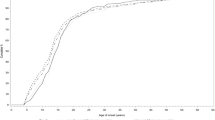Abstract
The ABC Schizophrenia Study, a large-scale epidemiological and neurobiological research project commenced in 1987, initially pursued two aims: (1) to elucidate the possible causes of the sex difference in age at first admission for schizophrenia and (2) to analyse the early course of the disorder from onset until first contact and its implications for further course and outcome. First, transnational case-register data (for Denmark and Germany) were compared, second, a population-based sample of first-episode cases of schizophrenia (n = 232) were selected and third, the results obtained were compared with data from the WHO Determinants of Outcome Study by using a systematic methodology. A consistent result was a 3–4 years higher age of onset for women by any definition of onset, which was not explainable by social variables, such as differences in the male-female societal roles. A sensitivity-reducing effect of oestrogen on central D2 receptors was identified as the underlying neurobiological mechanism in animal experiments. Applicability to humans with schizophrenia was established in a controlled clinical study. A comparison of familial and sporadic cases showed that in cases with a high genetic load, the sex difference in age of onset disappeared due to a clearly reduced age of onset in women, whereas in sporadic cases it increased. To analyse early course retrospectively, a semistructured interview, IRAOS, was developed. The early stages of the disorder were reconstructed in comparison with age- and sex-matched controls from the same population of origin. The initial signs consisted mainly of negative and affective symptoms, which accumulated exponentially until the first episode, as did the later emerging positive symptoms. Social disability appeared 2–4 years before first admission on average. In early-onset cases, social course and outcome, studied prospectively over 5 years, was determined by the level of social development at onset through social stagnation. In late-onset cases, decline from initially high social statuses occurred. Socially negative illness behaviour contributed to the poor social outcome of young men. Symptomatology and other proxy variables of the disorder showed stable courses and no sex differences. Further aspects tested were the sequence of onset and the influence of substance abuse on the course of schizophrenia, primary and secondary negative symptoms, structural models and symptom clusters from onset until 5 years after first admission.
Similar content being viewed by others
Author information
Authors and Affiliations
Additional information
Accepted: 19 February 1998
Rights and permissions
About this article
Cite this article
Häfner, H., Maurer, K., Löffler, W. et al. The ABC schizophrenia study: a preliminary overview of the results. Soc Psychiatry Psychiatr Epidemiol 33, 380–386 (1998). https://doi.org/10.1007/s001270050069
Issue Date:
DOI: https://doi.org/10.1007/s001270050069




